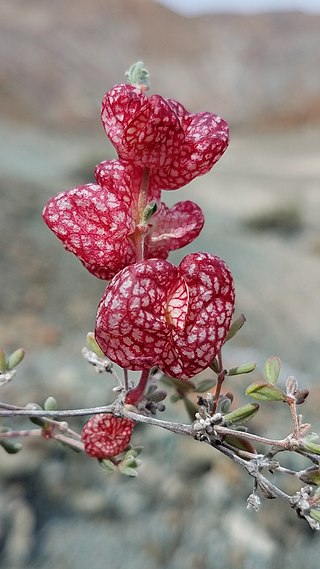
Harfordia macroptera is a woody perennial in the family Polygonaceae commonly known as rabbit's purse. It is the sole species in the genus Harfordia, which is endemic to the Baja California Peninsula. This plant is characterized by a unique, conspicuous bladder embellished with red to purple veins that surround the fruit. The sac-like structure is actually a dramatically modified bract, and assists in dispersal of the seeds through the wind.

Eriogonum wrightii is a species of wild buckwheat known by the common names bastardsage and Wright's buckwheat. It is native to the Southwestern United States, California, and northwest Mexico, where it grows in many plant communities, such as chaparral, in rocky habitats from mountains to deserts.

Euphorbia misera is a semi-succulent shrub in the genus Euphorbia commonly known as the cliff spurge or coast spurge. A drought-deciduous shrub, it is typically found as a gnarled, straggly plant occupying seashore bluffs, hills and deserts. Like other members of its genus, it has a milky sap, which can be found exuding out of the light gray bark when damaged. The alternately-arranged leaves are round and folded in the middle, with small hairs on them. The "flowers" can be found blooming year-round, and are colored maroon or yellow in the center with 5 white to light-yellow petal-like appendages attached outside. This species is native to the Baja California peninsula and Sonora in Mexico, and the coast of southern California in the United States, where it is a rare species. It is threatened in some localities by the development of its coastal habitat, which tends to be prime locations for high-end residential and commercial developments.

Pachycormus is a monotypic genus of flowering plants in the cashew family commonly known as the Baja elephant tree, torote blanco, or copalquín. The single species Pachycormus discolor is endemic to the Baja California peninsula, with three varieties. This sarcocaulescent tree or shrub is characterized by its unique gnarled growth habit, skin-like exfoliating bark, and succulent nature, whose appearance has been colorfully described as "the proboscis of an elephant holding a nosegay," a "huge radish protruding from the ground," or "grotesque resemblances of the flexed limbs of a corpulent human being." This drought-deciduous species spends most of the year dormant, but following rains pinnate green leaves emerge, and in the late spring to summer the leaves yellow, fall, and give way to bright red, cream, or pink flowers that give it a striking appearance in bloom.

Antigonon leptopus is a species of perennial vine in the buckwheat family commonly known as coral vine or queen's wreath. This clambering vine is characterized by showy, usually pink flowers that can bloom throughout the year and large, heart-shaped leaves. A. leptopus is native to the Pacific and Atlantic coastal plains of Mexico, but also occurs as a roadside weed from Mexico south to Central America. It is widely introduced and invasive throughout tropical regions of the world, including in the south and eastern United States, the West Indies, South America, and the Old World tropics of Asia and Africa. This species is utilized for its edible tubers and seeds, but also for its horticultural properties as an ornamental vine in warmer parts of the world.
Carterella is a monotypic genus of flowering plants in the family Rubiaceae. The genus contains only one species, viz. Carterella alexanderae, which is endemic to Baja California Sur in Mexico. It grows on steep slopes in the mountains.
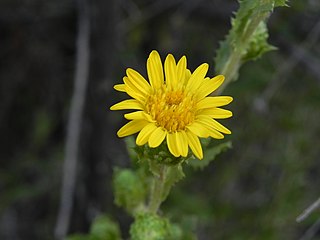
Hazardia berberidis is a species of flowering plant in the family Asteraceae commonly known as the barberry-leaf goldenbush. A woody shrub, it is characterized by sawtooth leaves and yellow ray flowers that bloom from March to August. It is endemic to the coastal sage scrub and coastal succulent scrub habitats of Baja California, Mexico, but with populations of uncertain origin in San Diego County, California.

Xylonagra arborea is a flowering plant endemic to the western side of the Baja California Peninsula. It is a bushy shrub distinguished by showy, scarlet flowers that are attractive to hummingbirds. It is the sole species in the genus Xylonagra, which belongs to the family Onagraceae.

Dudleya acuminata is a species of succulent perennial plant in the family Crassulaceae known by common name as the Vizcaino liveforever. A rosette-forming leaf succulent, it has reddish yellow flowers that emerge from April to May. It is native to the Pacific coast of the Vizcaino Desert on the Baja California Peninsula, and on neighboring islands.
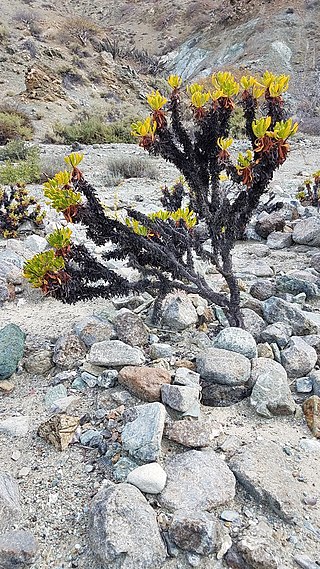
Eriogonum preclarum, known commonly as the Puerto Nuevo buckwheat, is a very rare species of perennial wild buckwheat in the family Polygonaceae. It is endemic to the Vizcaíno Peninsula in Baja California Sur, occurring on ultramafic substrates.

Jatropha moranii is a very rare subshrub in the genus Jatropha known commonly as Moran's lomboy. This species in the family Euphorbiaceae is endemic to a small area of Cabo San Lucas in Baja California Sur. It is characterized by a succulent stem and branches, along with a distinct woody caudex, and attractive white flowers.

Ibervillea sonorae is a tuberous perennial plant in the Cucurbitaceae family known by the common names wereke, wareque, guarequi, and coyote melon. It is a highly variable species characterized by a large, succulent tuberous root, which in the dry sand of its native habitat resembles a gray, dust-covered boulder. Emerging from the root yearly are long, flexible liana-like shoots, which reach a length of three or more meters. This species is native to northwestern Mexico, being found in the states of Baja California, Baja California Sur, Sonora and Sinaloa.

Ebenopsis confinis is a species of drought deciduous perennial shrubs in the Legume family known commonly as dog poop bush. The English vernacular name is a result of the distinctive woody fruits which resemble dog poop. The plant is referred to locally as palo fierro. In addition to the fruits, this species is characterized by its small, equally-paired pinnate leaves and a condensed capitulum. This species is distributed from southern Baja California to the cape of Baja California Sur, and on the coast of Sonora.

Lysiloma candidum, most commonly known as the palo blanco, is a tree of the family Fabaceae near-endemic to the Baja California Peninsula in Mexico. It may grow to a height of 10 metres (33 ft) and is one of the few spineless woody legumes in the region. It has compound leaves with oval gray-green leaflets. The creamy-white, globose clusters of flowers bloom in March through May and perfume the air with a light, spicy fragrance. The flowers are followed by red-brown pods up to 15 centimetres (5.9 in) long that hang delicately on the thin branches. This species is distributed throughout the Baja California Peninsula, from Rancho El Barril in southern Baja California state to the Cape region of Baja California Sur, and is also very rarely found in the state of Sonora.
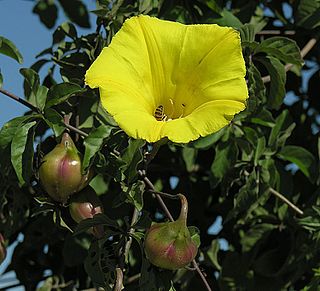
Distimake aureus is a species of vining plant in the bindweed family (Convolvulaceae) commonly known as the yellow morning-glory, yellow woodrose or yuca vine. A woody vine, this species is characterized by its large trumpet-shaped yellow flowers that bloom year-round, though most often after rain. Each of the showy flowers are only open for a single day. It is endemic to Baja California Sur, Mexico, where it can be found twining and climbing over trees, shrubs, and rocks.

Lepechinia hastata is a rare species of perennial shrub in the mint family commonly known as the Cape pitcher sage or Baja pitcher sage. Lepechinia hastata is an aromatic shrub characterized by large, arrowhead-shaped leaves and attractive purple to magenta flowers. In the wild, it is known from the forested mountains of the Sierra de la Laguna in Baja California Sur and the volcanic Socorro Island in the Pacific Ocean, both part of Mexico. The plants of Socorro Island are their own subspecies, and differ in their white flowers and wooly, grayer foliage.
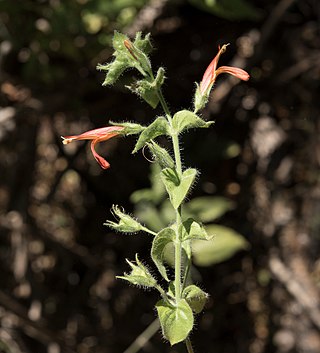
Justicia purpusii is a species of flowering plant in the Acanthus family commonly known as Purpus' hummingbird flower or chuparosa. This shrub is characterized by long orange-red tubular flowers that bloom from November to April. It is endemic to the Cape region of Baja California Sur, Mexico, where it is found growing in tropical deciduous forest and thorn scrub in canyons and along wet slopes. It is similar to its more northern relative adapted to drier climates, Justicia californica. Phylogenetic analysis has shown that both species are closely related and form a clade.

Ruellia californica is a species of flowering plant in the Acanthus family commonly known as the rama parda or flor del campo. This evergreen shrub is native to the Baja California peninsula and neighboring coastal Sonora. It is characterized by showy, funnelform blue-purple flowers that bloom throughout the year. There are two subspecies, one endemic to Baja California Sur, and they primarily differ in their presence or absence of hairs on their foliage. This plant is cultivated as an ornamental, and is used to provide a colorful accent to desert and dry gardens.

Justicia austrocapensis is a species of perennial herb in the Acanthus family commonly known as the Cape tube-tongue or chuparrosa. J. austrocapensis is characterized by solitary, pink, two-lipped tubular flowers up to 27 mm (1.1 in) long that emerge from the leaf axils. It is one of two Justicia species endemic to the Cape region of Baja California Sur, the other being the larger, shrubby, red-flowered Justicia purpusii. It is most similar to other species formerly placed in Siphonoglossa, such as Justicia sessilis of the West Indies and South America.

Gambelia juncea is a species of flowering shrub in the plantain family commonly known as the Baja California bush snapdragon or Baja bush snapdragon. Gambelia juncea is a highly variable woody perennial to 1 m (3.3 ft) characterized by long, arching, reed-like stems and showy, bright red, two-lipped tubular flowers. Native to the Baja California peninsula and coastal Sonora, this species is widespread in the region across numerous habitats and has several varieties. It was formerly placed in the primarily South American genus Galvezia, but taxonomic studies have supported the reclassification of the two North American species into Gambelia. This species, with a number of cultivars, is widely used as an ornamental shrub for xeriscaping, erosion control, native plant gardens, and wildlife gardens.





















